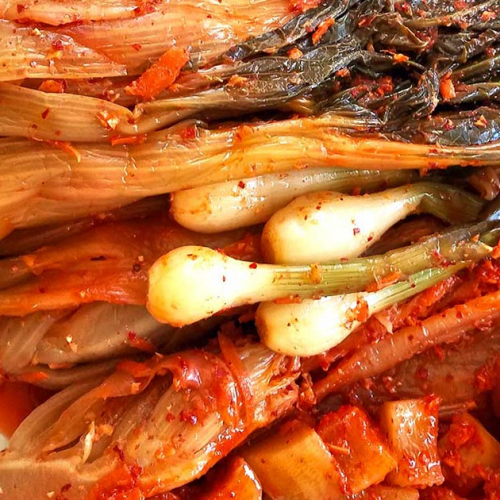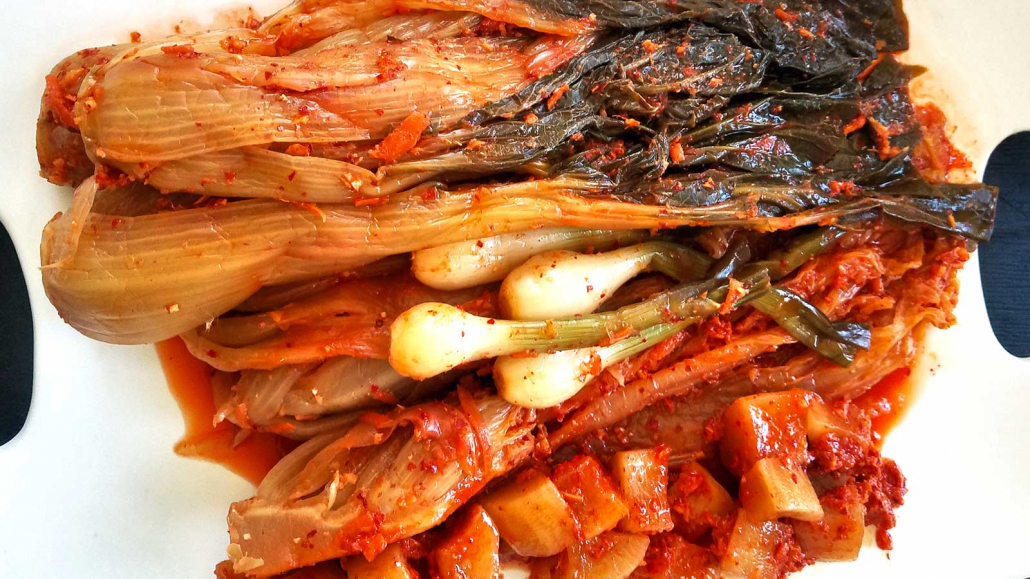Kimchi

Kimchi
Use this recipe to preserve anything the Korean kimchi way. This recipe is going to start with a shopping excursion for most people. The ingredients are all available at any Korean or Pan-Asian market. Just make sure to get the right kind of salt!
Equipment
- Mortar & Pestle
- 4 Qt. Wide Mouth Jars
- Drilled Lids with Rubber Seals
- Twin-Bubble Airlocks
Ingredients
- 4 lbs. cruciferous vegetables like cabbage, radish, and bok choy
- 140 g carrot shred or julienne
- 2 percent Korean Sea Salt best quality coarse
For the gochugaru paste
- 60 g gochugaru Korean hot chili flakes
- 6 g dried shrimp or dried anchovy
- 65 g garlic fresh
- 110 g ginger fresh
- 60 g fish sauce Red Boat brand or better
- 25 g soy sauce
- 45 g plum vinegar or use saki, plum wine, shiokoji, lacto-plum sauce etc.
- 200 g distilled water to cover, if needed
Instructions
- Make sure to source real Korean ingredients where noted. The sea salt is the purest I've ever seen and will always be non-iodized. The really good stuff is raked by hand until it is the perfect size for making incredible kimchi. The same goes for the dried shrimp or anchovies and gochugaru 'go-choo-ga-roo' chili flakes. You can ask for them and "Korean salt" at any Asian market and they usually have a whole selection to choose from. I don't speak the language, so I just buy the most expensive kind. Be prepared to buy a large amount of each. You will use more than you think and it keeps forever.

- Prepare the vegetables into whatever shape you want your finished kimchi. I prefer to quarter large heads of cabbage, cut bok choy in half, and leave radishes whole with their green ponytails attached. For large daikon, rutabaga, or turnip roots I usually go with 1-inch cubes and cucumbers get sliced 4-ways but left connected at the hilt. Do it however makes you happy, the important thing is to rinse your vegetables with several changes of fresh cold water until they are fastidiously clean.

- Once the cut vegetables are clean, rub them generously with salt and gently crunch the cell walls and stems with your hands. This is where the coarser salt will help you to break down the fibers and begin to draw out moisture. Let them drain on a cloth or cutting board set at and angle in the sink for about 20 minutes. Then rinse most of this salt off in cold water, drain, and spin or pat dry with clean towels.
- While the vegetables are draining, use a mortar and pestle to make the paste of garlic, ginger, dried shrimp, and gochugaru. If you use a food processor, everything you make in it will always taste like kimchi. Plus it won't be as smooth. Then add the soy sauce, fish sauce, and Lacto-plum liquid.

- Use a gram scale to weigh the gochugaru paste and the drained vegetables. Multiply the total weight by .02 to calculate how many grams of salt must be added to the gochugaru. This will always result in kimchi with overall salinity above 2%, suitable for lactic acid bacteria fermentation but safe from spoilage.

- Using gloves, rub the gochugaru paste all up inside the vegetables' nooks and crannies. Squeeze out as many trapped bubbles as you can and fold/arrange gochu-covered vegetables inside your jars leaving minimum air pockets. It helps to have a sauerkraut tamper, fermentation weights or a Mexican bean smasher to mash down inside the jars. If you don't have wide mouth jars, you can get away with fermenting kimchi in 1-gallon double-sealed ziplocks by squeezing all the air out by submerging in water. This works fine, but you'll want to double or even triple layer the airtight freezer bags or else kimchi odor will take over your fridge, apartment, closet, neighbor's dog, and anything else in the vicinity.

- If your kimchi is very dry, you may want to wait a day to see how much liquid it gives off once the salt begins to draw out moisture. Over the next 4 days, it should remain covered in liquid and mashed down daily to get rid of any trapped air bubbles. If you still think it needs more liquid, mix 200g of distilled water with 4g of salt (2% salinity) and add to your jar until the kimchi is just covered.

- Well-made Kimchi, stored airtight, never really goes bad, but it does become Mook Eun Ji after about 6 months.

- The juices of this very old kimchi enrich many delciously-complex Korean stews and braising sauces, like the Beef Shanks with Old Kimchi Jjigae pictured here.




Leave a Reply
Want to join the discussion?Feel free to contribute!